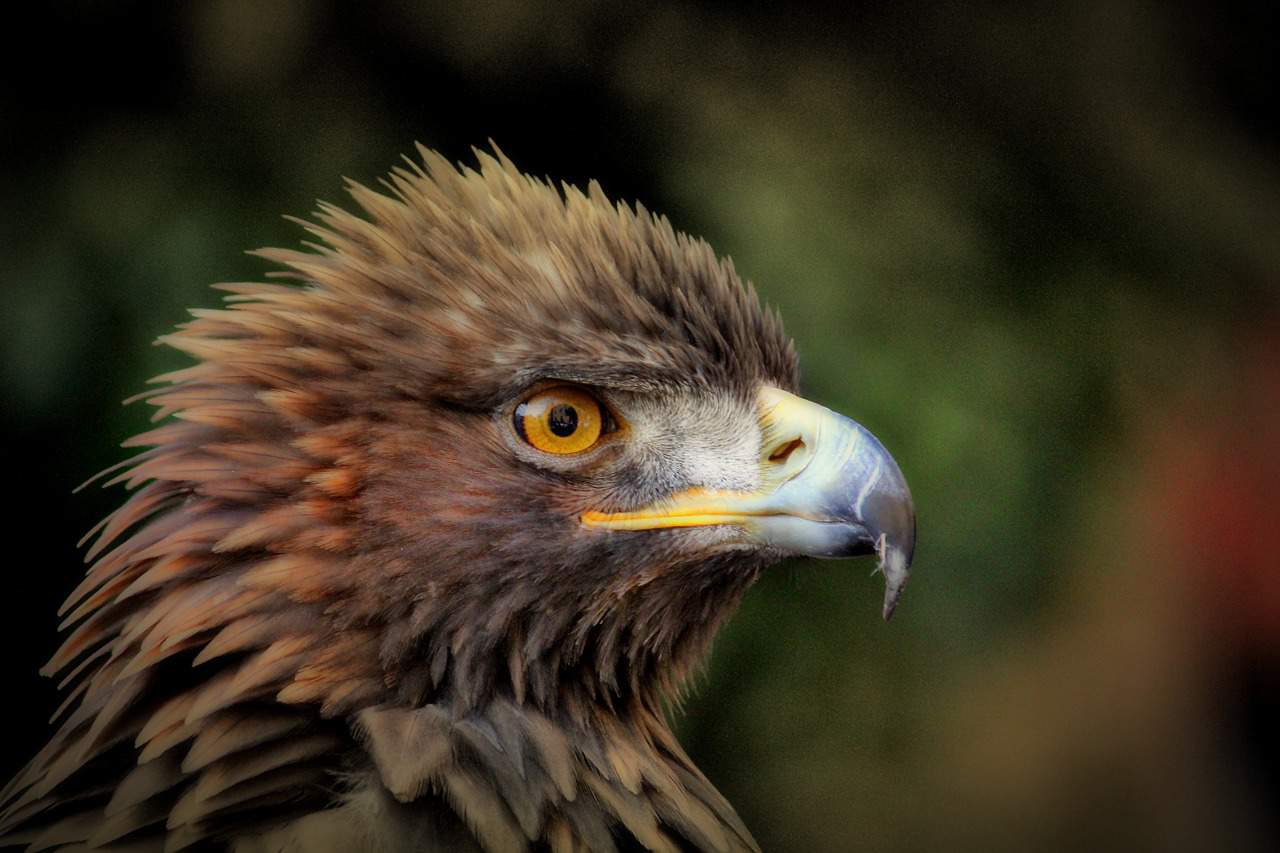
Eagles are among the strongest birds of prey. Despite its many types, all eagles have something in common – they are expert fliers and hunters. Eagles balance aggression with gracefulness, thus earning their title as birds of prey. Take a closer look at these animals through these Eagle facts.
- Eagle is a general name for most large birds of prey.
- Birds of prey primarily hunt and eat on vertebrates.
- Eagles have powerful legs, strong talons, and big hooked beaks.
- Eagle eyes are big and weigh almost the same as the human eyes (10 lbs).
- The majority of eagle species live in Asia and Africa.
- The United States and Canada only have two eagle species.
- Their eyes are angled 30° away from the center of its face. Providing them better aerial vision.
- Eagles can detect UV light and can identify colors better than humans.
- The South Nicobar Serpent Eagle is the smallest species of the eagle, weighing 450 grams and growing 16 inches long.
- The Steller’s Sea Eagle is the biggest eagle species, weighing as much as 9 kilograms with wingspans of over 7 feet.
- Eagles are monogamous.
- Both male and female eagles build their nests.
- The eagle’s nest is made of vegetation, sticks, and downy feathers.
- Eagles have different preferences in nest altitude.
- An eagle typically lays 1-4 eggs.
Eagle Facts Infographics

An eagle has 1 million cones per mm² on its retina.
One of the main reasons why an eagle has better eyesight is because of its retinas. The light-detecting cells of an eagle have more cones at the back of the eyeball. For instance, a human eye has 200,000 cones per mm², compared to an eagle’s eye with one million cones per mm².
Eagles commonly feed on fish.
Eagles primarily prey on fish, but they can also eat other variations of animals and birds. This includes small mammals such as rodents, bats, and even reptiles such as snakes.
The average eagle has a lifespan of 20 years.
Eagles usually live in the wild for 20-30 years. In contrast to most birds, its lifespan is considerably longer. The oldest known eagle in the wild lived for as long as 38 years old.
Eagles in captivity live longer.
For instance, if an eagle lives in a zoo, it can reach up to 50-70 years of age because of veterinary care. However, an eagle in the wild will start to weaken in its twenties, eventually being unable to grab prey.
Eagle beaks bend with age.
Eagles may be apex predators at the top of their food chain, but they don’t stay that way forever. Aside from the weakening of its talons, eagle beaks warp and bend upon aging. Once their beaks change shape, it’d be hard for them to feed.
January 10th is the Save the Eagles Day.
Every year on January 10th, Save the Eagles Day reminds everyone of conserving these vulnerable species. With the efforts of scientists and environmentalists, other eagle species such as the bald eagle aren’t endangered anymore.
The bald eagle is one of the national symbols of the United States.
Because of its majestic looks, strength, and longevity, the United States chose the bald eagle as one of its national symbols on June 20, 1782. Equally important, the bald eagle also represents freedom for the country and its people.
The Philippine eagle is the Philippines' national bird.
Scientifically known as Pithecophaga Jefferyi, the Philippine eagle was declared the country’s national bird in 1978 through Proclamation No. 1732. The Philippine Eagle is now an endangered species under the family Accipitridae.

Eagles can fly as high as 15,000 feet.
Eagles only use little energy when they are flying high. Although they can soar altitudes of 10,000 feet to 15,000 feet, they fly in long glides to conserve energy.
Eagles can fly up to 160 kilometers per hour.
Eagles are one of the fastest birds on the planet. They can fly as fast as a speeding car at 120-160 km per hour. However, the fastest bird is the Peregrine falcon which flies at an average of 390 km per hour.
Baby eagles reach full growth at 12 weeks old.
By the time they’re 12 weeks old, eaglets are fully grown. This is also the period where they take their first flight.
Eagles don't actually push their eaglets to learn how to fly.
Contrary to popular belief, eagles don’t push their eaglets to learn how to fly. Instead, the adults would delay feeding the eaglets once they feel that they should learn how to hunt and fly.
The United States protects eagles seriously.
It’s forbidden to track, capture, disturb, or do anything malicious to an eagle in the United States. For something as minor as seeing an eagle feather on the ground, you would need a special permit to pick it up.
The bald eagle's name comes from an Old English word.
The bald eagle is called bald not for its lack of hair. The word bald came from an Old English word “Balde” which means “White.” Thus, bald eagles are named for its head’s distinctly white color.

Eagles know how to balance their feathers.
To keep their balance and glide smoothly in the air, eagles will shed a feather on one side when the other side loses it as well.
Eagles don't mate in the air.
In general, eagles don’t mate in the air, but the courtship occurs there. Mating usually occurs on branches or nests with the male mounting the female eagle. During sex, the cloaca of the male and female joins together and the male’s sperm will be transferred to the female. This process is known as the ‘cloacal kiss.’
Eagles mate for life.
When eagles choose a partner, it’s ‘Till’ death do us part.‘ As mentioned above, they are a monogamous species. However, if their partner dies early or does not return to the nest for a year or so, it would generally seek a new partner.
Eagles drop their prey to incapacitate them.
When an eagle needs to hunt and eat in mountainous terrains and spot larger prey, it will use its strong talons to grab them and throw them off the high cliff. After they drop dead from free-fall, the eagle will devour its meal.
There is a Dutch firm that trains eagles to assist drone control.
In the Netherlands, there is a firm that trains eagles to assist drone control. Typicall, an eagle is trained to catch falling drones and land them safely. Trainers would reward the eagle by giving it a piece of meat.
Police taskforces have also utilized eagles.
According to some reports, some drug pushers use drones as a high-tech delivery system, while others use them for burglary. As a result, police taskforces in Britain have started training eagles to take down these drones. Eagles are thought to see these drones as other birds overrunning their airspace.
Eagles have relatively high body heat.
Because eagles are warm-blooded creatures, they radiate their body heat. On average, eagles have a body temperature of 41°C or 106°F.
Eagle beaks are made of keratin.
Keratin is a fibrous structural protein known as scleroprotein. In other words, their beaks constantly grow, much like human hair and fingernails. This cycle keeps the beak in great shape throughout an eagle’s lifetime.

Over 100,000 eagles were killed during the 20th century.
During the early 20th Century, bald eagles were viewed as a threat to the salmon fishing industry. As a result, over 100,000 eagles were killed to protect the salmon industry.
Male and female eagle partners work as a traditional husband and wife.
Male and female eagles make a very good parenting tandem. The males’ job is to guarantee that there’s food in their nests, while the female roosts at their nest for 35 days to keep their eggs warm.
Female bald eagles are much heavier than males.
Typically, female bald eagles weigh 25% more than the male eagles. The average weight of a female bald eagle is 10-14 lbs while the males weigh between 7 and 10 lbs.
They are more active during the day.
Eagles are diurnal. They are more active during the day and sleep or rest at night. Eagles up wake as early as the sunrise, and sleep right away after sundown.
Eagles can work around the clock to fix their nest.
When the eagle’s nest is damaged or destroyed, the eagle gets a sense of urgency. Instead of following its routine on sleeping, they may work overtime until their nest is fixed.
The North American Eagle Project is designed to beat the fastest automobile.
The North American Eagle Project aimed to create a jet-powered automobile designed to beat the Thrust supersonic car’s speed record of 1,228 km per hour. However, tragedy struck when the late American professional racer Jessica M. Combs crashed the North American Eagle during its test drive on August 27, 2019.
The McDonnell Douglas F-15 Eagle fighter aircraft remains undefeated.
McDonnell Douglas designed the McDonnell Douglas F-15 Eagle as an all-weather tactical fighter aircraft. It is one of the most triumphant modern air fighters, with over 100 victories and no losses in aerial combat.
The Holy Bible mentions eagles over 30 times.
The Bible mentioned the eagle both in the New and Old Testament. The imagery of an eagle is often used throughout the Bible to portray God’s power.
Was this page helpful?
Our commitment to delivering trustworthy and engaging content is at the heart of what we do. Each fact on our site is contributed by real users like you, bringing a wealth of diverse insights and information. To ensure the highest standards of accuracy and reliability, our dedicated editors meticulously review each submission. This process guarantees that the facts we share are not only fascinating but also credible. Trust in our commitment to quality and authenticity as you explore and learn with us.
